Stelian Coros
Multi-Domain Motion Embedding: Expressive Real-Time Mimicry for Legged Robots
Dec 08, 2025Abstract:Effective motion representation is crucial for enabling robots to imitate expressive behaviors in real time, yet existing motion controllers often ignore inherent patterns in motion. Previous efforts in representation learning do not attempt to jointly capture structured periodic patterns and irregular variations in human and animal movement. To address this, we present Multi-Domain Motion Embedding (MDME), a motion representation that unifies the embedding of structured and unstructured features using a wavelet-based encoder and a probabilistic embedding in parallel. This produces a rich representation of reference motions from a minimal input set, enabling improved generalization across diverse motion styles and morphologies. We evaluate MDME on retargeting-free real-time motion imitation by conditioning robot control policies on the learned embeddings, demonstrating accurate reproduction of complex trajectories on both humanoid and quadruped platforms. Our comparative studies confirm that MDME outperforms prior approaches in reconstruction fidelity and generalizability to unseen motions. Furthermore, we demonstrate that MDME can reproduce novel motion styles in real-time through zero-shot deployment, eliminating the need for task-specific tuning or online retargeting. These results position MDME as a generalizable and structure-aware foundation for scalable real-time robot imitation.
Collaborative Loco-Manipulation for Pick-and-Place Tasks with Dynamic Reward Curriculum
Sep 16, 2025Abstract:We present a hierarchical RL pipeline for training one-armed legged robots to perform pick-and-place (P&P) tasks end-to-end -- from approaching the payload to releasing it at a target area -- in both single-robot and cooperative dual-robot settings. We introduce a novel dynamic reward curriculum that enables a single policy to efficiently learn long-horizon P&P operations by progressively guiding the agents through payload-centered sub-objectives. Compared to state-of-the-art approaches for long-horizon RL tasks, our method improves training efficiency by 55% and reduces execution time by 18.6% in simulation experiments. In the dual-robot case, we show that our policy enables each robot to attend to different components of its observation space at distinct task stages, promoting effective coordination via autonomous attention shifts. We validate our method through real-world experiments using ANYmal D platforms in both single- and dual-robot scenarios. To our knowledge, this is the first RL pipeline that tackles the full scope of collaborative P&P with two legged manipulators.
RAMBO: RL-augmented Model-based Optimal Control for Whole-body Loco-manipulation
Apr 09, 2025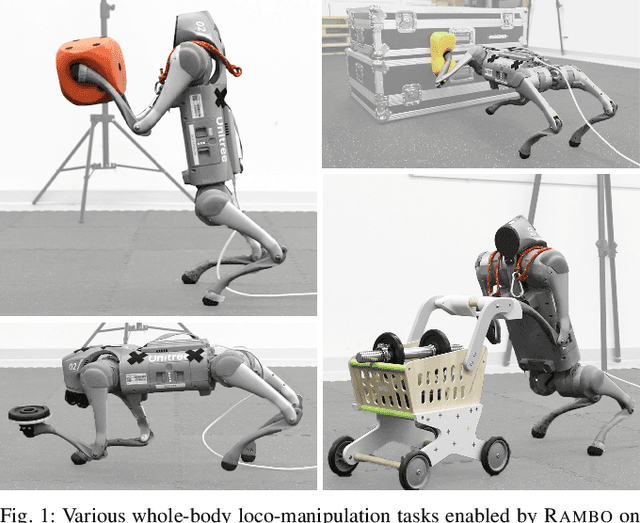
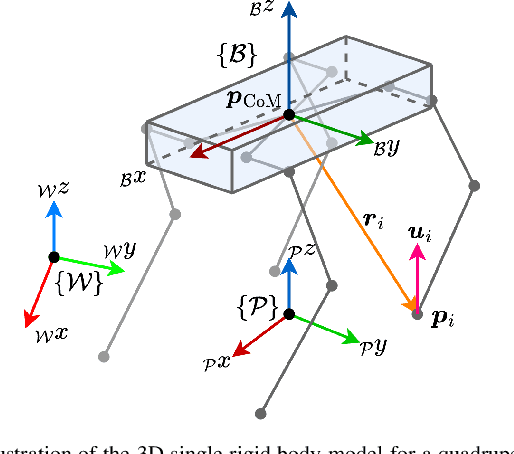


Abstract:Loco-manipulation -- coordinated locomotion and physical interaction with objects -- remains a major challenge for legged robots due to the need for both accurate force interaction and robustness to unmodeled dynamics. While model-based controllers provide interpretable dynamics-level planning and optimization, they are limited by model inaccuracies and computational cost. In contrast, learning-based methods offer robustness while struggling with precise modulation of interaction forces. We introduce RAMBO -- RL-Augmented Model-Based Optimal Control -- a hybrid framework that integrates model-based reaction force optimization using a simplified dynamics model and a feedback policy trained with reinforcement learning. The model-based module generates feedforward torques by solving a quadratic program, while the policy provides feedback residuals to enhance robustness in control execution. We validate our framework on a quadruped robot across a diverse set of real-world loco-manipulation tasks -- such as pushing a shopping cart, balancing a plate, and holding soft objects -- in both quadrupedal and bipedal walking. Our experiments demonstrate that RAMBO enables precise manipulation while achieving robust and dynamic locomotion, surpassing the performance of policies trained with end-to-end scheme. In addition, our method enables flexible trade-off between end-effector tracking accuracy with compliance.
A Benchmark for Optimal Multi-Modal Multi-Robot Multi-Goal Path Planning with Given Robot Assignment
Mar 05, 2025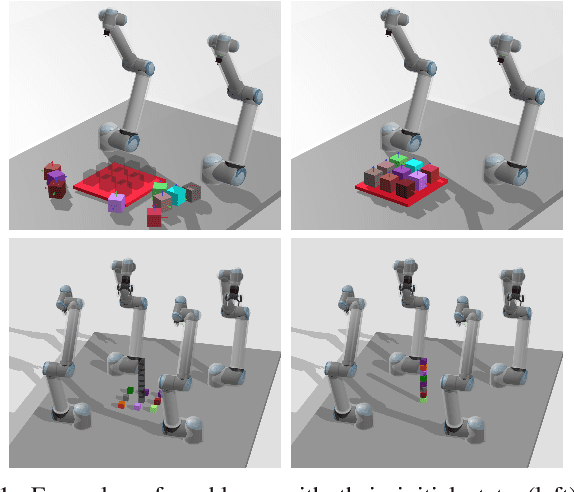
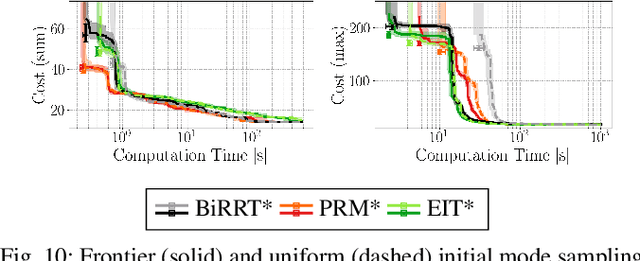

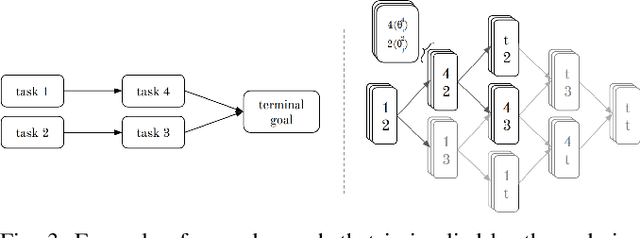
Abstract:In many industrial robotics applications, multiple robots are working in a shared workspace to complete a set of tasks as quickly as possible. Such settings can be treated as multi-modal multi-robot multi-goal path planning problems, where each robot has to reach an ordered sequence of goals. Existing approaches to this type of problem solve this using prioritization or assume synchronous completion of tasks, and are thus neither optimal nor complete. We formalize this problem as a single path planning problem and introduce a benchmark encompassing a diverse range of problem instances including scenarios with various robots, planning horizons, and collaborative tasks such as handovers. Along with the benchmark, we adapt an RRT* and a PRM* planner to serve as a baseline for the planning problems. Both planners work in the composite space of all robots and introduce the required changes to work in our setting. Unlike existing approaches, our planner and formulation is not restricted to discretized 2D workspaces, supports a changing environment, and works for heterogeneous robot teams over multiple modes with different constraints, and multiple goals. Videos and code for the benchmark and the planners is available at https://vhartman.github.io/mrmg-planning/.
A comparison of visual representations for real-world reinforcement learning in the context of vacuum gripping
Mar 04, 2025



Abstract:When manipulating objects in the real world, we need reactive feedback policies that take into account sensor information to inform decisions. This study aims to determine how different encoders can be used in a reinforcement learning (RL) framework to interpret the spatial environment in the local surroundings of a robot arm. Our investigation focuses on comparing real-world vision with 3D scene inputs, exploring new architectures in the process. We built on the SERL framework, providing us with a sample efficient and stable RL foundation we could build upon, while keeping training times minimal. The results of this study indicate that spatial information helps to significantly outperform the visual counterpart, tested on a box picking task with a vacuum gripper. The code and videos of the evaluations are available at https://github.com/nisutte/voxel-serl.
CAIMAN: Causal Action Influence Detection for Sample Efficient Loco-manipulation
Feb 02, 2025Abstract:Enabling legged robots to perform non-prehensile loco-manipulation with large and heavy objects is crucial for enhancing their versatility. However, this is a challenging task, often requiring sophisticated planning strategies or extensive task-specific reward shaping, especially in unstructured scenarios with obstacles. In this work, we present CAIMAN, a novel framework for learning loco-manipulation that relies solely on sparse task rewards. We leverage causal action influence to detect states where the robot is in control over other entities in the environment, and use this measure as an intrinsically motivated objective to enable sample-efficient learning. We employ a hierarchical control strategy, combining a low-level locomotion policy with a high-level policy that prioritizes task-relevant velocity commands. Through simulated and real-world experiments, including object manipulation with obstacles, we demonstrate the framework's superior sample efficiency, adaptability to diverse environments, and successful transfer to hardware without fine-tuning. The proposed approach paves the way for scalable, robust, and autonomous loco-manipulation in real-world applications.
Learning More With Less: Sample Efficient Dynamics Learning and Model-Based RL for Loco-Manipulation
Jan 17, 2025



Abstract:Combining the agility of legged locomotion with the capabilities of manipulation, loco-manipulation platforms have the potential to perform complex tasks in real-world applications. To this end, state-of-the-art quadrupeds with attached manipulators, such as the Boston Dynamics Spot, have emerged to provide a capable and robust platform. However, both the complexity of loco-manipulation control, as well as the black-box nature of commercial platforms pose challenges for developing accurate dynamics models and control policies. We address these challenges by developing a hand-crafted kinematic model for a quadruped-with-arm platform and, together with recent advances in Bayesian Neural Network (BNN)-based dynamics learning using physical priors, efficiently learn an accurate dynamics model from data. We then derive control policies for loco-manipulation via model-based reinforcement learning (RL). We demonstrate the effectiveness of this approach on hardware using the Boston Dynamics Spot with a manipulator, accurately performing dynamic end-effector trajectory tracking even in low data regimes.
MaxInfoRL: Boosting exploration in reinforcement learning through information gain maximization
Dec 16, 2024



Abstract:Reinforcement learning (RL) algorithms aim to balance exploiting the current best strategy with exploring new options that could lead to higher rewards. Most common RL algorithms use undirected exploration, i.e., select random sequences of actions. Exploration can also be directed using intrinsic rewards, such as curiosity or model epistemic uncertainty. However, effectively balancing task and intrinsic rewards is challenging and often task-dependent. In this work, we introduce a framework, MaxInfoRL, for balancing intrinsic and extrinsic exploration. MaxInfoRL steers exploration towards informative transitions, by maximizing intrinsic rewards such as the information gain about the underlying task. When combined with Boltzmann exploration, this approach naturally trades off maximization of the value function with that of the entropy over states, rewards, and actions. We show that our approach achieves sublinear regret in the simplified setting of multi-armed bandits. We then apply this general formulation to a variety of off-policy model-free RL methods for continuous state-action spaces, yielding novel algorithms that achieve superior performance across hard exploration problems and complex scenarios such as visual control tasks.
Multi-robot workspace design and motion planning for package sorting
Dec 15, 2024Abstract:Robotic systems are routinely used in the logistics industry to enhance operational efficiency, but the design of robot workspaces remains a complex and manual task, which limits the system's flexibility to changing demands. This paper aims to automate robot workspace design by proposing a computational framework to generate a budget-minimizing layout by selectively placing stationary robots on a floor grid, which includes robotic arms and conveyor belts, and plan their cooperative motions to sort packages from given input and output locations. We propose a hierarchical solving strategy that first optimizes the layout to minimize the hardware budget with a subgraph optimization subject to network flow constraints, followed by task allocation and motion planning based on the generated layout. In addition, we demonstrate how to model conveyor belts as manipulators with multiple end effectors to integrate them into our design and planning framework. We evaluated our framework on a set of simulated scenarios and showed that it can generate optimal layouts and collision-free motion trajectories, adapting to different available robots, cost assignments, and box payloads.
Problem Space Transformations for Generalisation in Behavioural Cloning
Nov 06, 2024



Abstract:The combination of behavioural cloning and neural networks has driven significant progress in robotic manipulation. As these algorithms may require a large number of demonstrations for each task of interest, they remain fundamentally inefficient in complex scenarios. This issue is aggravated when the system is treated as a black-box, ignoring its physical properties. This work characterises widespread properties of robotic manipulation, such as pose equivariance and locality. We empirically demonstrate that transformations arising from each of these properties allow neural policies trained with behavioural cloning to better generalise to out-of-distribution problem instances.
 Add to Chrome
Add to Chrome Add to Firefox
Add to Firefox Add to Edge
Add to Edge